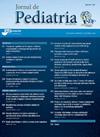Clinical and nutritional profile of children and adolescents with autism spectrum disorder in Brazil: a nationwide online survey
IF 2.5
4区 医学
Q1 PEDIATRICS
引用次数: 0
Abstract
Objective
To characterize the clinical and nutritional profile of children and adolescents with ASD in Brazil and their eating problems.
Method
This is a cross-sectional study using a national online survey, with a sample of 613 children and adolescents with ASD aged between 2 and 17 years. Data analysis consisted of descriptive analysis, followed by Pearson's chi-square test with a statistical significance of 0.05 and a 95% confidence interval.
Results
Food allergy was reported by 33.8% of the participants, the most frequent being cow's milk (70.2%), among those who reported gastrointestinal problems, constipation was the most frequent (54.1%). The presence of pica was reported by 25% and food selectivity was present in 77.2%, with greater refusal of fruit, vegetables and pasty textures. Most of the participants do not have follow-ups with a nutritionist and 44.5% are on some special diet, excluding gluten/wheat (75.4%) and without casein/animal milk (76.1%). More than half of the participants did not eat fruit (50.6%), vegetables (68.1%), or leafy greens (83.6%) frequently. A positive correlation was found between food selectivity and gastrointestinal symptoms (p-value < 0.050); food allergy and gastrointestinal symptoms (p-value < 0.001) and pica and gastrointestinal symptoms (p-value < 0.001).
Conclusions
The results of this study show changes in food consumption and increased risk of nutritional deficiencies for children and adolescents with ASD in Brazil.
巴西患有自闭症谱系障碍的儿童和青少年的临床和营养状况:一项全国性的在线调查。
目的:了解巴西儿童和青少年ASD的临床和营养状况及其饮食问题。方法:这是一项横断面研究,采用全国在线调查,样本为613名2至17岁的ASD儿童和青少年。资料分析采用描述性分析,Pearson卡方检验,统计学意义为0.05,置信区间为95%。结果:33.8%的参与者报告了食物过敏,最常见的是牛奶(70.2%),在报告胃肠道问题的人中,便秘最常见(54.1%)。据报道,有25%的人患有异食癖,77.2%的人有食物选择性,其中对水果、蔬菜和面糊质地的拒绝较多。大多数参与者没有与营养学家进行随访,44.5%的人有一些特殊的饮食,不包括麸质/小麦(75.4%)和不含酪蛋白/动物奶(76.1%)。超过一半的参与者不经常吃水果(50.6%)、蔬菜(68.1%)或绿叶蔬菜(83.6%)。食物选择性与胃肠道症状呈正相关(p值< 0.050);食物过敏和胃肠道症状(p值< 0.001)以及异食癖和胃肠道症状(p值< 0.001)。结论:这项研究的结果表明,巴西患有自闭症的儿童和青少年的食物消费发生了变化,营养缺乏的风险增加了。
本文章由计算机程序翻译,如有差异,请以英文原文为准。
求助全文
约1分钟内获得全文
求助全文
来源期刊

Jornal de pediatria
医学-小儿科
CiteScore
5.60
自引率
3.00%
发文量
93
审稿时长
43 days
期刊介绍:
Jornal de Pediatria is a bimonthly publication of the Brazilian Society of Pediatrics (Sociedade Brasileira de Pediatria, SBP). It has been published without interruption since 1934. Jornal de Pediatria publishes original articles and review articles covering various areas in the field of pediatrics. By publishing relevant scientific contributions, Jornal de Pediatria aims at improving the standards of pediatrics and of the healthcare provided for children and adolescents in general, as well to foster debate about health.
 求助内容:
求助内容: 应助结果提醒方式:
应助结果提醒方式:


